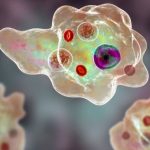 Mysteries
Mysteries  Mysteries
Mysteries  History
History 10 Surprising Stories About the Texas Rangers
 Humans
Humans 10 Philosophers Who Were Driven Mad by Their Own Theories
 Miscellaneous
Miscellaneous 10 Video-Game-Worthy Weapons and Armors from History
 Weird Stuff
Weird Stuff 10 Psychics Who Accurately Predicted Wartime Events
 The Arts
The Arts 10 Pieces of Art Inspired by a Broken Heart
 Health
Health 10 Science Fiction-Sounding New Medical Treatments
 History
History 10 Surprising Facts About the Father of Submarine Warfare
 Space
Space Ten Astonishing New Insights into Alien Worlds
 Weird Stuff
Weird Stuff 10 Bizarre Summer Solstice Rituals Still Practiced Today
 Mysteries
Mysteries Top 10 Haunting Facts About the Ghost Ship MV Alta
 History
History 10 Surprising Stories About the Texas Rangers
 Humans
Humans 10 Philosophers Who Were Driven Mad by Their Own Theories
Who's Behind Listverse?

Jamie Frater
Head Editor
Jamie founded Listverse due to an insatiable desire to share fascinating, obscure, and bizarre facts. He has been a guest speaker on numerous national radio and television stations and is a five time published author.
More About Us Miscellaneous
Miscellaneous 10 Video-Game-Worthy Weapons and Armors from History
 Weird Stuff
Weird Stuff 10 Psychics Who Accurately Predicted Wartime Events
 The Arts
The Arts 10 Pieces of Art Inspired by a Broken Heart
 Health
Health 10 Science Fiction-Sounding New Medical Treatments
 History
History 10 Surprising Facts About the Father of Submarine Warfare
 Space
Space Ten Astonishing New Insights into Alien Worlds
 Weird Stuff
Weird Stuff 10 Bizarre Summer Solstice Rituals Still Practiced Today
10 Secrets about the Food Industry They Don’t Want You to Know
In the modern world, there are so many food companies that spread misinformation and lies while hiding some very disturbing practices. This is because all companies have one primary objective: to make a profit. In order to do that they will do and say pretty much anything to get your hard-earned money. It is always good to investigate and question everything.
Related: 10 Misconceptions About Cooking And Food Safety
10 American Chicken Is So Bad That It Is Banned in the EU
The horrible conditions that American chickens are kept in from farm to slaughter are well documented. Once slaughtered, the carcasses are usually dipped in chlorine baths to kill microbes, though tests show that salmonella and listeria are still active after the wash. This is because the amount of chlorine required to kill 99% of bacteria is 100 to 150 ppm, but chlorine baths only have up to 50 ppm. For reference, a swimming pool has around 2 ppm.
This practice is part of why American chicken has been banned from entering the EU since 1997. Since the 1940s, chickens have also been fed arsenic-based drugs like Roxarsone and Nitarsone, which turn into carcinogenic inorganic arsenic in chicken bodies. They are also fed antibiotics, which is a contributor to the growing problem of antibiotic resistance that leads to about 700,000 deaths worldwide and two million illnesses annually in the United States alone.[1]
9 Michelin Stars Can Be More of a Curse than a Blessing
The modern Michelin guide has a three-star rating. An anonymous reviewer is sent to specific locations to judge them based on their rating criteria. While gaining a Michelin star rating for an establishment has benefits, such as an increase in sales and prestige, it also comes with a lot of problems as well. Stars gained must be maintained, and as such, chefs are under pressure to work long hours under strict guidelines.
Furthermore, inspections can happen at any time of the year anonymously, so one bad day can cost a restaurant their rating. As a result, there have been cases of chefs suing Michelin when they gain or lose a star. In some cases, restaurants choose to close their establishments altogether rather than deal with the added pressure and restrictions.[2]
8 Lab-Grown Meat Is Still Worse than Regular Meat
What if we could avoid slaughtering animals while still enjoying delicious beef and reducing our emissions of greenhouse gases? Well, in order to grow that meat in giant tanks, a special ingredient called fetal bovine serum or FBS is required. FBS is acquired when a pregnant cow is slaughtered, and then its unborn fetus is drained of its blood.
Furthermore, in order to grow tissue in a lab instead of an animal, you need expensive pharmaceutical-grade equipment, which requires a lot of energy to run. Researchers found the carbon dioxide equivalents emitted per kilogram of meat produced to be 4 to 25 times greater than that of regular beef.[3]
7 Chocolate Is Made with Child Slave Labor
Two-thirds of the world’s supply of cocoa beans comes from West Africa. The country of the Ivory Coast alone accounts for about 45% of the global supply. A 2015 report found that more than two million children were used as labor in the cocoa-growing regions of West Africa. In the Ivory Coast, most parents in the cocoa regions cannot afford to educate their children, so they use them as farm labor instead. Other laborers are trafficked from even poorer countries such as neighboring Burkina Faso and Mali.
Traffickers from these countries offer children as young as ten years old money and other gifts to entice them to get on a bus to the Ivory Coast. Once they arrive, they face back-breaking manual labor all year round for about 85 cents a day if they are lucky. A 2009 Tulane survey found that about half of interviewees were not allowed to go back home, and more than two-thirds had experienced threats and physical violence. Some also indicated that they were never paid.[4]
6 Kobe and Wagyu Beef Sold in America Is Rarely Authentic
You may have noticed how the number of restaurants with Kobe and Wagyu beef on the menu has increased. How did super rare, expensive meat become so ubiquitous and cheap? Well, that is because it is likely not the real deal. “Wagyu” means “Japanese cow” and refers to black, brown, polled, and shorthorn Japanese breeds.
Kobe beef is the most acclaimed of all the regional wagyu produced in Japan. All the Kobe beef-producing cows are inseminated with just 12 special bulls in the Hyogo region. Only three to four thousand heads of cattle per year qualify as authentic Kobe beef, and only a fraction of that makes it to America. Only eight restaurants in the whole United States serve actual Kobe beef, and it is never sold in retail.
At least non-Kobe beef Wagyu is legit, right? Not likely. According to the American Wagyu Association, less than five thousand of a total of forty thousand Wagyu-influenced cows in America qualify as purebred. The rest fall under the F1 (50% pure), F2 (75% pure) and F3 (93.75% pure) ranking system. Odds are the Wagyu beef at your local restaurant is an F1.[5]
5 Bottled Water Is Mostly Tap Water
Tap water in the United States is not the best. There are traces of antibiotics, painkillers, hormones, and a ton of other drugs that Americans flush down the drain that water treatment plants currently cannot filter out. There are also PFAS, which are linked to liver damage, immune dysfunction, kidney and testicular cancer, thyroid disease, and many more illnesses. The per- and polyfluoroalkyl substances (PFAS) are a group of chemicals used to make fluoropolymer coatings and products that resist heat, oil, stains, grease, and water.
An estimated 200 million Americans have their tap water contaminated with PFAS. Americans drink more packaged water overall than any other country in the world. A report found that almost half of bottled water is just tap water that may have been tested and processed a tiny bit more. Bottled water also produces a lot of plastic waste that rarely gets recycled.[6]
4 Olive Oil Labels Are Probably Lying to You
Olives are harvested on autumn and winter nights and placed into metal crushers. Once crushed and slowly mixed into a paste, it is sent to a centrifuge, where the oil is segregated from the rest. It is then graded into three categories. The highest quality is known as extra virgin olive oil, the medium quality is virgin olive oil, and the lowest is lampante olive oil.
Unless bought from a producer or a certified distributor, Italian extra virgin olive oil is likely a counterfeit. It is estimated that about 80% of Italian olive oil on the market is fake. The situation is not much better in Italy either, where an estimated 50% of olive oil is fake.
A study by the National Consumer League found that 6 of 11 bottles from Whole Foods, Safeway, Trader Joe’s, and Giant did not meet extra virgin olive oil standards set by the International Olive Council (IOC). Mislabeling of extra virgin olive oil can be due to the use of rotten olives during production, old oils, or even the addition of seed oils.[7]
3 Oatly Is Not as Healthy as Advertised
If you suffer from lactose intolerance, then you may have shopped for healthy alternatives. One such alternative that you may have seen plastered in ads everywhere is Oatly. A look at the ingredients list tells more. The primary sugar in Oatly is maltose. A 12 oz portion has a glycemic index of 77 and a glycemic load of 18.4. This has a similar impact on blood sugar levels as a 12 oz cola, which has a glycemic index of 63 and a glycemic load of 20.8.
Oatly also has rapeseed oil, which contains fatty acids called omega-3. The production process of rapeseed oil leads to the oxidation of omega-3. This is bad because there is evidence that this oxidation can cause heart disease, organ damage, inflammation, and cancer. Overall, rapeseed oil consumption has been linked to cardiovascular disease and metabolic syndrome, decreased brain function, Alzheimer’s disease, inflammation, and other health problems.
Another ingredient is dipotassium phosphate. High amounts of phosphates in the blood have been linked to a number of health issues, such as poor bone health, calcium deposits, hardening of the arteries in the heart, and an elevated risk of cardiovascular disease.[8]
2 Supermarkets Are Designed to Manipulate You into Spending More
It all starts at the entrance with the shopping carts. Since 1937, the size of a shopping cart has tripled to make buyers buy more items. Supermarkets often have one-way entry doors, which means you have to walk further to get out again. Once you are inside, the first thing you see is the produce section and sometimes the bakery section. This is done to make you hungry and upbeat with the aroma of freshly baked goodies, flowers, and glossy-looking veggies and fruits. The produce is well-lit and sprayed with fresh water to appear fresher, even though spraying them makes vegetables spoil faster.
The dairy section is intentionally placed far away so that you pass a bunch of distractions to get to what you need. The shelves are a trap, too. The priciest items are at eye level, while the cheaper stuff is at crouch or tippy toe level. Researchers also found that cereal packaging for kids is designed in a way that mascots are looking at the kids while on shelves at a child’s height. Music and the lack of windows and clocks help increase the time spent shopping.[9]
1 Never Buy Commercial Pet Food
The labeling on pet food can be kind of confusing in terms of what percentage of meat is contained. For now, let’s ask where these pet food companies get their meat from. The disgusting answer is rendering plants, which are basically giant kitchens that cook raw animal carcasses to remove moisture and fat. At a rendering plant, you will be greeted by piles of thousands of dead dogs and cats, rats, skunks, and raccoons, and hooves and heads from sheep, horses, pigs, and cattle. All that plus a dash of millions of maggots feasting on them.
But let’s not forget about the toxic waste, which includes pesticide-laced livestock, cattle insecticide patches, flea collars, antibiotics in livestock, and heavy metals from pet ID tags, surgical needles, and pins. Then, there’s the organo-phosphates from contaminated fish, euthanasia drugs from dead pets, and finally, all the plastic from unsold supermarket meats, chicken, and fish.
That is just the meat part of pet food. The rest is made up of grains that are unfit for human consumption, preservatives, fillers, and additives. All this is packaged in pet food bags that were found to be contaminated with PFAS. PFAS do not break down in nature and accumulate in animals and humans, causing kidney disease, liver disease, birth defects, and cancer.
You should probably not listen to your vet about your pet’s nutrition, either. Many universities accept funding from the big three pet food companies and even allow employees from them to lecture future vets on nutrition. Even The American Veterinary Medical Association is in their pocket.[10]








